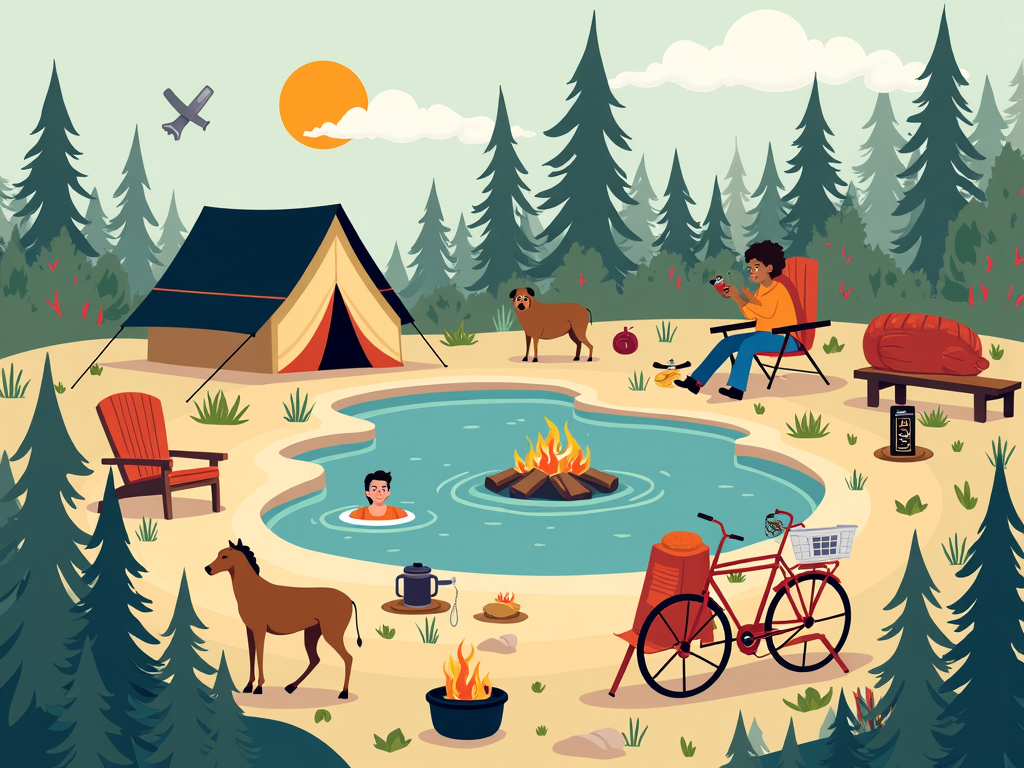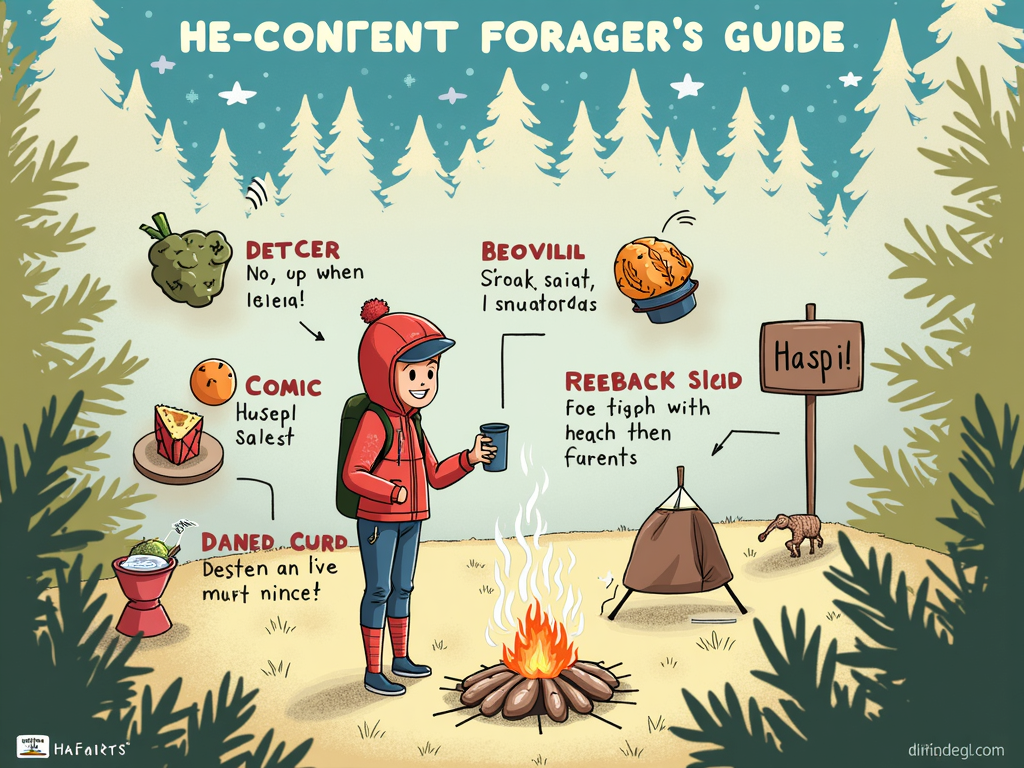Here’s what nobody tells you about camping meals. You don’t have to choose between eating like a survivalist or hauling a kitchen on your back.
The camping food game changed when James Beard-recognized chefs started designing freeze-dried meals and foraging apps hit 2 million downloads. Yeah, you read that right. The same award that goes to fancy restaurants now goes to stuff you can stuff in a backpack.

But here’s where it gets interesting.
The real revolution isn’t just better dehydrated food. It’s what happens when you combine that $12 pouch of gourmet goodness with fresh wild garlic you spotted using your phone. Suddenly, you’re not just eating to survive the outdoors. You’re creating meals that would cost forty bucks in the city, using nothing but a Jetboil and some ingenuity.
Welcome to hybrid foraging – where modern convenience meets ancient wisdom, and your camping meals guide just got a serious upgrade.
The Tech-Enabled Forager: Apps and Safety for Wild Enhancement
Most people think foraging means wandering around hoping you don’t poison yourself. That’s outdated thinking.
Today’s foragers use apps like Wild Edibles and PictureThis that literally show you GPS-mapped safe zones in National Parks and KOA Campgrounds. These aren’t your grandpa’s field guides. They give real-time toxicity warnings and tell you exactly how much you can harvest without being a jerk to nature.
Here’s what blows people’s minds: The apps now integrate with park databases. You point your phone at a plant, it tells you if it’s edible, shows you similar poisonous look-alikes, and even checks if you’re in a protected area where harvesting is prohibited. No more guessing games.
The 1/3 rule is gospel here. Never take more than a third of what you find. It’s not just about being nice to nature – it’s smart foraging. Leave enough for wildlife and regeneration. Plus, you’re not trying to feed an army. You need just enough wild onions or miner’s lettuce to transform that Mountain House pad thai into something special.
What Actually Works for Easy Camping Meals
The real game-changer? These apps track what’s in season where you’re camping. Planning a trip to Yosemite in June? Your app already knows what’s growing there. Wild strawberries, elderflowers, maybe some chickweed. Each one turns basic camping food ideas into something memorable.
But let’s be blunt. Don’t be an idiot. Start with the obvious stuff – dandelions, clover, wild garlic. These grow everywhere and are basically impossible to mess up. Save the mushroom hunting for when you actually know what you’re doing. The apps help, but common sense helps more.

Now that you’ve got your fresh ingredients sorted, let’s talk about what you’re actually adding them to.
Chef-Designed Freeze-Dried Meets Fresh: Building Layered Camp Meals
Gone are the days when freeze-dried meant cardboard-flavored sadness. Good To-Go literally won James Beard recognition. Let that sink in. The same people judging Michelin-starred restaurants are giving awards to camping food. Mountain House hired actual chefs. Backpacker’s Pantry isn’t just throwing salt at dehydrated vegetables anymore.
Here’s the strategy that changes everything. You start with these premium bases – we’re talking wild mushroom risotto, pad thai, Cuban rice bowls. Already decent on their own. But then you hit them with fresh foraged greens, wild onions, maybe some berries you found. Boom. Restaurant quality in the backcountry.
Camping Meal Planning That Actually Works
Let me paint you a picture. You’ve got a pouch of freeze-dried mac and cheese. Not bad, but nothing special. Now add fresh wild mustard greens you found by the creek, some foraged wild onions, maybe a handful of sheep sorrel for tang. What was a $12 dehydrated camping meal just became a $40 gastropub dish. Same calories, same packability, infinitely better taste.
The trick is understanding flavor profiles. Those camping dinner recipes are designed to be complete, but they’re also designed to be enhanced. They’ve got the protein, the carbs, the base flavors. What they’re missing is freshness, texture, that pop of something alive. That’s where your foraged additions come in.
Timing matters too. Don’t dump everything in at once. Rehydrate your base meal first. Then add hardy greens that can take some heat. Save delicate flowers or fresh herbs for the very end. It’s not rocket science, but most people get it wrong. They either overcook their foraged additions or add them too early and lose all that fresh flavor.
And yeah, you’re doing all this with just a Jetboil or MSR stove. One pot camping meals at their finest. Minimal cleanup. That’s the beauty of it.
But what about the waste? All those pouches and packaging? That’s where things get really interesting.
Zero-Waste Camp Kitchen: Compostable Solutions and Storage Systems
Here’s what REI doesn’t advertise loudly enough: camping food packaging just went through a quiet revolution. Fully compostable meal pouches exist now. Not “biodegradable in 500 years” nonsense. Actually compostable. You can bury them following Leave No Trace guidelines, and they’re gone in weeks, not centuries.
The weight savings alone make this worth talking about. Traditional freeze-dried pouches? You’re packing those out. Every single one. Five days of meals means five days of trash weighing down your pack. But these new compostable options? You’re packing out 80% less waste. That’s not a typo.
Smart Camping Food Storage Solutions
Bear safety hasn’t been forgotten either. Yeti and other brands figured out how to make bear-proof containers that don’t weigh like boat anchors. The new systems cut weight by 40% compared to old-school bear canisters. They’re using space-age materials that bears can’t crush but won’t break your back.
Here’s the system that works: Plan your meals backward. Start with what packaging you’ll have to deal with. Choose compostable when possible. For everything else, repackage at home into reusable silicone bags. Yeah, it takes an extra twenty minutes of camping meal prep before your trip. But you’ll thank yourself when you’re not hauling garbage up a mountain.
Storage gets smarter too. Those foraged additions? They go in breathable mesh bags, not plastic. Keeps them fresh without creating condensation that leads to rot. Your high-tech freeze-dried meals stay in their pouches until needed. Everything organized, minimal waste, maximum efficiency.
The dirty secret about camping food storage? Most people way overcomplicate it. You don’t need seventeen different containers. You need one good bear-proof container, a few reusable bags, and a system. That’s it. The minimalist approach isn’t just trendy – it’s practical.
Building Your Camping Food List
So how do you put all this together into an actual meal plan? Let me show you exactly how the Hybrid Forager Method works.
Start with your base camping grocery list. For a three-day trip, that’s:
- 3 premium freeze-dried dinners (Go for variety – Thai, Mexican, Italian)
- 3 camping breakfast ideas (instant oatmeal gets way better with fresh berries)
- Lightweight camping food for lunch (wraps, nut butters, dried fruit)
- Camping snacks ideas (nuts, energy bars, dried mango)
Then layer in your foraged additions. Each meal gets enhanced with 2-3 fresh elements. Your camping lunch ideas suddenly include fresh watercress. That boring oatmeal? Now it’s got wild strawberries and edible flowers.
The Complete Camping Meals Guide in Action
Look, camping meals don’t have to suck anymore. The old trade-off between convenience and quality? Dead. When freeze-dried food wins culinary awards and your phone can identify edible plants better than most field guides, the game has fundamentally changed.
The Hybrid Forager Method isn’t some complex system. It’s common sense meeting technology. Download an app, pick some quality base meals, add fresh ingredients nature provides. That’s it. You’re not trying to become a wilderness survival expert or a backcountry chef. You’re just making camp food that doesn’t taste like cardboard while actually respecting the places you visit.
Zero waste, maximum flavor, minimal effort.
Start small. Next trip, download Wild Edibles. Pick up one premium freeze-dried meal from Mountain House or Backpacker’s Pantry. Find three common edibles near your campsite. See what happens when you combine them.
Once you taste the difference, there’s no going back to basic camping food.
The wilderness kitchen just got a serious upgrade. Time to use it.